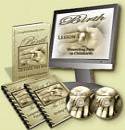The "Business" of Birthing
The information presented below represent factual birthing statistics within the United States. The average delivery in the U.S. is neither natural nor healthy. American obstetricians are taught to view birth as "a disaster waiting to happen." As a society, we have embraced a cascading system of successively more intense, unneeded interventions termed "active management" or the "standard of care". As the following facts illustrate, birth outcomes have suffered as a result:
- Each year, the U.S. spends over $80 billion dollars on childbirth. This is more than any other nation in the world. (This number does not include babies in the NICU or readmissions during the first month.)
- Maternity care is the largest source of income for American hospitals.
- The U.S. ranks 37th in the world for the quality of its health care.
- Over HALF of all hospital admissions in America are for maternity.
- Hospitals are NOT the safest place to have a baby. 25 infectious strains exist that are resistant to ALL known antibiotics. These are found primarily in hospitals.
- 75 years of routine hospital birth have produced NO studies to show it is safer than having a baby at home with a skilled birth attendant.
- Both homebirth and birth centers have been scientifically proven to be as safe or safer than hospitals with a skilled labor attendant (i.e. midwives, not doctors).
- The more technology used in childbirth, the more dangerous it becomes.
- The larger the hospital, the greater the risks to both mother and baby.
- Of the 4.3 million babies born annually in the U.S., a mere 5% represent natural childbirth.
- America ranks 29th in the world for its infant mortality rate, the number of babies who die in their first year per 1,000 live births, meaning the US loses more babies than 28 other nations per year.
- The U.S.A. ranks 14th among developed nations for its maternal mortality ratio, the ratio of maternal deaths per 100,000 live births, meaning 13 other countries lose less mothers within 6 weeks of childbirth than the US does per year.
- Over 90% of all infants in the U.S. are born with drugs (e.g. narcotics from epidurals, pitocin, acetaminophen, etc) in their systems. NONE of these drugs have been tested for safe use in infants.
- A 24-hour hospital stay, uncomplicated delivery in the U.S.A. costs anywhere from $8,000-10,000. This cost DOUBLES for a c-section.
- ALL families in the U.S. are charged newborn nursery charges, even if the baby NEVER leaves the mother's room. This "routine" charge amounts to about $1.3 billion dollars annually, for services that are NOT rendered.
- Every year, 1 million, or about 20%, full-term, healthy infants are sent to the NICU for "observation" for an average stay of 3 days, totaling a whopping $6,000.
- For newborns suspected to have serious medical conditions, the same NICU stay totals $20,000.
- 1 in 3 American women has an episiotomy. Episiotomies are medically indicated for less than 10% of all women. Over 1 million unnecessary episiotomies are performed annually in the U.S.
- 1 in 5 births in the U.S.A. are induced. 44% of women surveyed in 2002 reported their doctor wanted to induce. Only 16% reported medically-indicated reasons.
- American women who elect epidurals are FOUR times as likely to have cesarean sections.
- 31.8% of American babies (nearly 1 in 3) in 2007 were delivered by cesarean section. The World Health Organization recommends a c-section rate of less than 10-15% as acceptable.
- U.S. hospital policies for routine tests, practices, policies and procedures are based on financial considerations, which include malpractice insurance costs. They are not based on evidence, research, or appropriateness of care.
While these statistics are disturbing in themselves and aptly illustrate the overmedicalization of American maternity care, the true injustice occurs when these views are exported across the world. As the U.S. is a powerhouse of marketing, more impressionable regions are adopting these practices, despite the overwhelming evidence that the U.S. approach to childbirth is seriously flawed.
We as a country must reach beyond our own boundaries to embrace an evidence-based model of maternity care. We, as women, mothers, fathers and expectant families, must educate ourselves as to the true process of labor and childbirth, intervening only when necessary.
References
http://www.cdc.gov/nchs/data/nvsr/nvsr57/nvsr57_12.pdfhttp://www.cdc.gov/nchs/data/nvsr/nvsr56/nvsr56_07.pdf
http://www.motherfriendly.org/Downloads/induct-fact-sheet.pdf
Deneux-Tharaux D, Berg C, Bouvier-Colle MH, Gissler M, Harper M, Nannini A, Alexander S, Wildman K, Breart G, Buekens P. Underreporting of Pregnancy-Related Mortality in the United States and Europe. Obstet Gynecol 2005;106:684-92.
http://www.who.int/whr/2005/en/
Hartmann K, Viswanathan M, Palmieri R, Gartlehner G, Thorp J, Lohr KN (2005). "Outcomes of routine episiotomy: a systematic review". JAMA 293 (17): 2141–8. doi:10.1001/jama.293.17.2141. PMID 15870418.
(2006) "ACOG Practice Bulletin. Episiotomy. Clinical Management Guidelines for Obstetrician-Gynecologists. Number 71, April 2006". Obstet Gynecol 107 (4): 95762. PMID 16582142.
http://www.unicef.org/publications/index_18108.html
http://www.cdc.gov/nchs/fastats/obgyn.htm
http://www.bmj.com/cgi/content/full/330/7505/1416?ehom
Macfarlane A, McCandlish R, Campbell R. Choosing between home and hospital delivery. There is no evidence that hospital is the safest place to give birth. British Medical Journal. 2000 Mar 18;320(7237):798.
Home versus hospital birth.
Cochrane Database Syst Rev 2000;(2)
The cost-effectiveness of home birth. Journal of Nurse-Midwifery. 44(1):30-5, 1999 Jan-Feb.
http://www.kff.org/womenshealth/upload/whp061207othd.pdf
http://www.childbirthconnection.org/article.asp?ck=10401
http://www.bmj.com/cgi/content/full/318/7189/995
Peck P. Preinduction cervical ripening significantly increases risk of cesarean. Medscape Medical News, 2003
Goer H. The Thinking Woman's Guide to a Better Birth. New York: Perigee Books, 1999, p 228-9.
Fullerton JT and Severino R. In-hospital care for low-risk childbirth: comparison with results from the NationalBirth Center Study. J Nurse Midwifery 1992;37(5):331-340.
Return from Business of Birthing to Giving Birth Naturally Home
Page Last Modified by Catherine Beier, MS, CBE
Most Popular
How to Use Acupressure to Induce Labor
Childbirth Relaxation Script MP3s
Nutrition During Pregnancy - Nix the Notion of Eating for Two
Looking for a Birth Professional? Search our Provider Directory
Online Childbirth Classes
Choose 7 week, 12 week, or Self- Paced online childbirth classes available wherever and whenever you need them.
Featured Birth Story
Vanessa's natural birth story shows that when birth is left alone to proceed as it should, it waits for no one - not even doctors or midwives.
Free Pregnancy Tickers
Create a free pregnancy ticker to post on your blog, website, Facebook profile or favorite social media...




